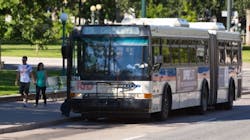Denver area transit partners request entry into FTA’s Small Starts for Colfax Avenue BRT project
The Denver Regional Transportation District (RTD), in collaboration with the city and county of Denver, has requested entry into the Federal Transit Administration (FTA) Small Starts project development phase for the Colfax Avenue Bus Rapid Transit (BRT) project. Small Starts is part of FTA’s Capital Investment Grants Program and requesting entry is the first step to be considered for up to $100 million in funding for the project.
“We’re grateful for the FTA Small Starts program that invests in corridor-based rapid transit projects and are confident Colfax BRT would be a phenomenal choice to receive funding through the program,” said Denver Mayor Michael B. Hancock. “We have our project partners in place, a locally preferred alternative and $55 million for the project approved by voters in the Elevate Denver Bond. Colfax BRT spotlights Denver’s and the region’s commitment to improving public transportation and moving more people in our community to jobs, healthcare and other opportunities, all of which keep Denver a great place to live.”
The application is an important step toward advancing development of the 9.9-mile Colfax Avenue corridor that extends from Union Station in downtown Denver to the R Line Colfax Station in Aurora. The corridor serves many population and employment concentrations, key activity centers and high ridership destinations.
The Colfax Avenue BRT project, led by the city of Denver, is intended to address growing travel needs along the corridor, including an anticipated sharp rise in travel demand and increasing traffic congestion. Current demand for RTD’s 15/15L bus service along Colfax is higher than all other RTD routes. While nationwide transit ridership dropped sharply to 20 percent of pre-pandemic levels, Colfax corridor bus ridership remained at more than 60 percent of prior ridership levels — nearly three times the national average.
RTD predicts Colfax BRT service will reduce bus travel time by 20-25 percent and increase corridor ridership by 35-40 percent in 2040 with additional growth over time, benefiting population and employment centers served by the corridor.
Implementation of the project is expected to significantly enhance multimodal connectivity, while reducing vehicle miles traveled and greenhouse gas emissions.
“BRT will vastly enhance this corridor by providing transit-supportive development and efficient, equitable connections to downtown Denver, the Anschutz Medical Campus in Aurora and destinations across the RTD network that are vital to the customers we serve,” RTD General Manager and CEO Debra A. Johnson said of the project.
Johnson credits Denver and supporting project partners, including the Colorado Department of Transportation (CDOT) and Denver Regional Council of Governments (DRCOG), who have aligned their roles to lay the groundwork for the project’s future success.
“This project illustrates the significant role of innovation and collaboration contributing to the optimal growth of a city,” Johnson said.
The request to enter in the project development phase is part one of a multi-year process. In August 2022, the partners will apply for a project score and in 2023, provide the FTA with a cost estimate and official funding request. If the FTA approves the Small Starts application, RTD will serve as sponsor for the project.
Colfax Avenue is the first of several BRT corridors identified in Denver’s “Denver Moves Transit Plan.” BRT corridors connect key activity centers, reduce transit travel times, improve ridership connectivity, reduce reliance on automobiles and encourage new economic vitality, including transit-oriented development near stations.
RTD is exploring innovative local partnerships around the region as part of the agency’s two-year Reimagine RTD effort to meet the transportation needs of the future.
